Developmental Psychology: Childhood Deprivation, Theories, and Cases
VerifiedAdded on 2022/08/13
|9
|2867
|15
Essay
AI Summary
This essay delves into the field of developmental psychology, exploring the impact of childhood deprivation on human behavior and psychological development. It examines the negative consequences of lacking proper parental care, education, and basic needs during childhood, and how these deprivations can lead to mental, emotional, and physical health issues. The essay analyzes the attachment theories of John Bowlby and Mary Ainsworth, highlighting their perspectives on the crucial role of parent-child bonding in shaping a child's development. Furthermore, it presents case studies of feral children, such as Oxana and Genie, to illustrate the interplay of nature versus nurture in determining a child's psychological outcomes. Through these analyses, the essay aims to provide a comprehensive understanding of the complexities of developmental psychology and the factors that influence a child's growth and well-being.
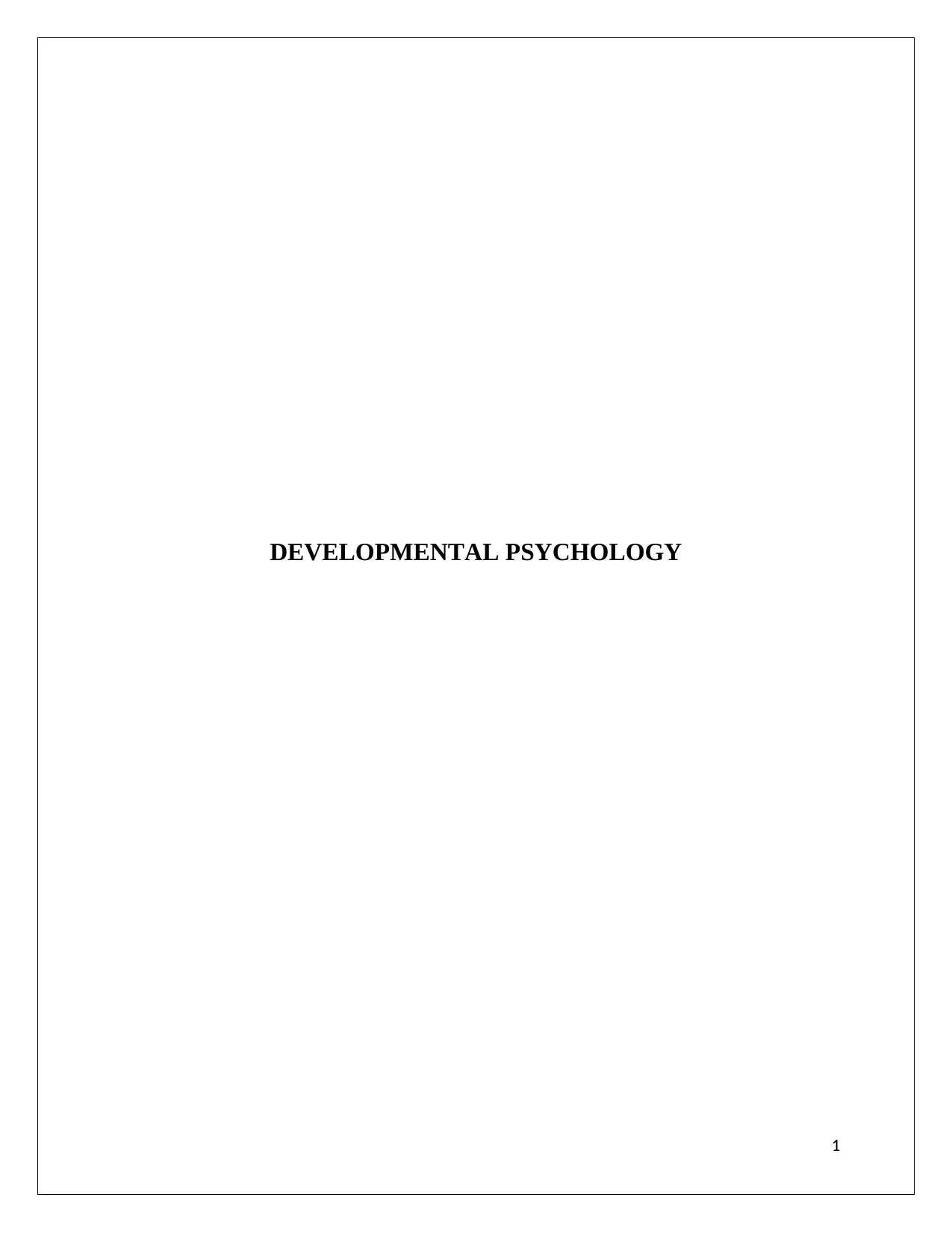
DEVELOPMENTAL PSYCHOLOGY
1
1
Paraphrase This Document
Need a fresh take? Get an instant paraphrase of this document with our AI Paraphraser
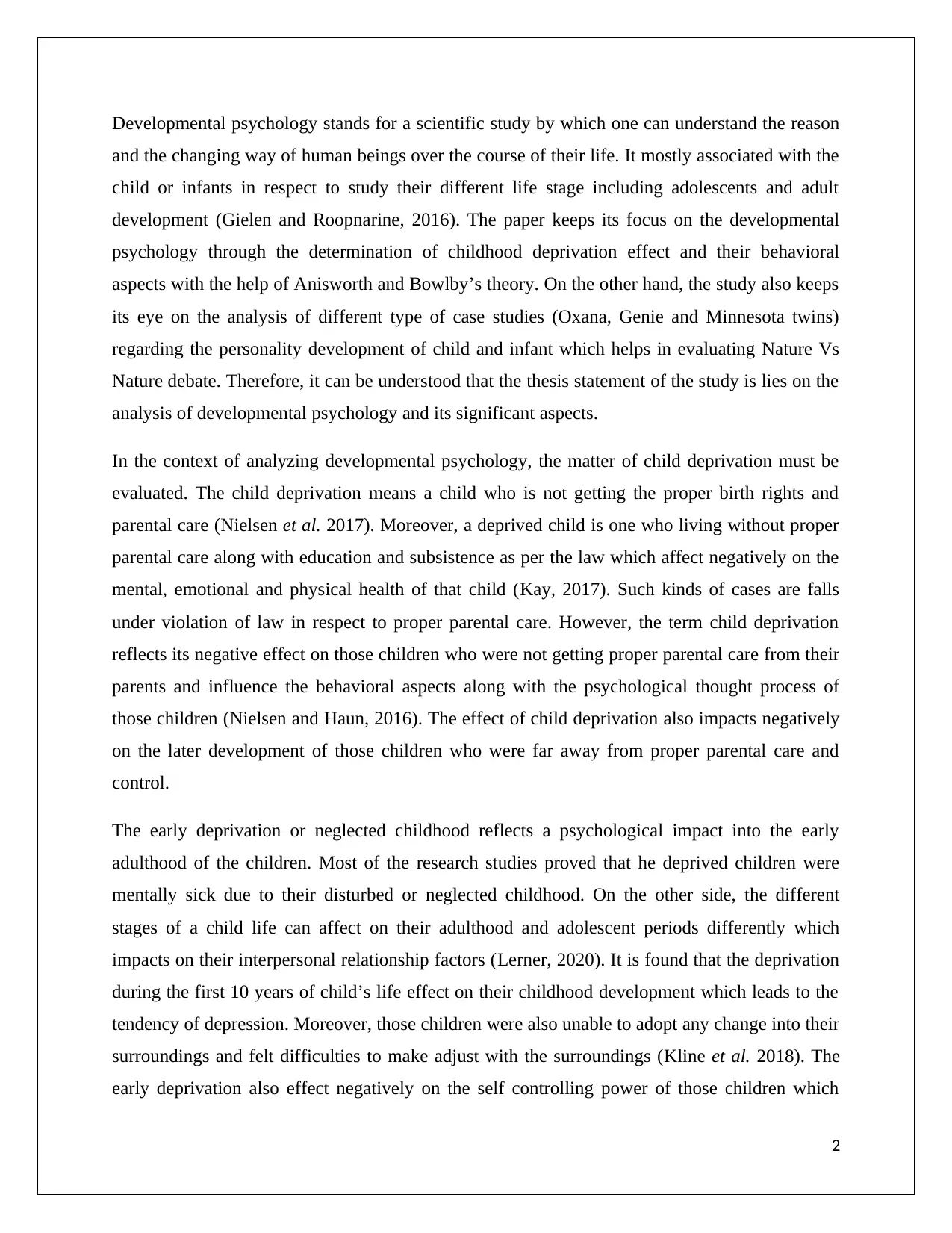
Developmental psychology stands for a scientific study by which one can understand the reason
and the changing way of human beings over the course of their life. It mostly associated with the
child or infants in respect to study their different life stage including adolescents and adult
development (Gielen and Roopnarine, 2016). The paper keeps its focus on the developmental
psychology through the determination of childhood deprivation effect and their behavioral
aspects with the help of Anisworth and Bowlby’s theory. On the other hand, the study also keeps
its eye on the analysis of different type of case studies (Oxana, Genie and Minnesota twins)
regarding the personality development of child and infant which helps in evaluating Nature Vs
Nature debate. Therefore, it can be understood that the thesis statement of the study is lies on the
analysis of developmental psychology and its significant aspects.
In the context of analyzing developmental psychology, the matter of child deprivation must be
evaluated. The child deprivation means a child who is not getting the proper birth rights and
parental care (Nielsen et al. 2017). Moreover, a deprived child is one who living without proper
parental care along with education and subsistence as per the law which affect negatively on the
mental, emotional and physical health of that child (Kay, 2017). Such kinds of cases are falls
under violation of law in respect to proper parental care. However, the term child deprivation
reflects its negative effect on those children who were not getting proper parental care from their
parents and influence the behavioral aspects along with the psychological thought process of
those children (Nielsen and Haun, 2016). The effect of child deprivation also impacts negatively
on the later development of those children who were far away from proper parental care and
control.
The early deprivation or neglected childhood reflects a psychological impact into the early
adulthood of the children. Most of the research studies proved that he deprived children were
mentally sick due to their disturbed or neglected childhood. On the other side, the different
stages of a child life can affect on their adulthood and adolescent periods differently which
impacts on their interpersonal relationship factors (Lerner, 2020). It is found that the deprivation
during the first 10 years of child’s life effect on their childhood development which leads to the
tendency of depression. Moreover, those children were also unable to adopt any change into their
surroundings and felt difficulties to make adjust with the surroundings (Kline et al. 2018). The
early deprivation also effect negatively on the self controlling power of those children which
2
and the changing way of human beings over the course of their life. It mostly associated with the
child or infants in respect to study their different life stage including adolescents and adult
development (Gielen and Roopnarine, 2016). The paper keeps its focus on the developmental
psychology through the determination of childhood deprivation effect and their behavioral
aspects with the help of Anisworth and Bowlby’s theory. On the other hand, the study also keeps
its eye on the analysis of different type of case studies (Oxana, Genie and Minnesota twins)
regarding the personality development of child and infant which helps in evaluating Nature Vs
Nature debate. Therefore, it can be understood that the thesis statement of the study is lies on the
analysis of developmental psychology and its significant aspects.
In the context of analyzing developmental psychology, the matter of child deprivation must be
evaluated. The child deprivation means a child who is not getting the proper birth rights and
parental care (Nielsen et al. 2017). Moreover, a deprived child is one who living without proper
parental care along with education and subsistence as per the law which affect negatively on the
mental, emotional and physical health of that child (Kay, 2017). Such kinds of cases are falls
under violation of law in respect to proper parental care. However, the term child deprivation
reflects its negative effect on those children who were not getting proper parental care from their
parents and influence the behavioral aspects along with the psychological thought process of
those children (Nielsen and Haun, 2016). The effect of child deprivation also impacts negatively
on the later development of those children who were far away from proper parental care and
control.
The early deprivation or neglected childhood reflects a psychological impact into the early
adulthood of the children. Most of the research studies proved that he deprived children were
mentally sick due to their disturbed or neglected childhood. On the other side, the different
stages of a child life can affect on their adulthood and adolescent periods differently which
impacts on their interpersonal relationship factors (Lerner, 2020). It is found that the deprivation
during the first 10 years of child’s life effect on their childhood development which leads to the
tendency of depression. Moreover, those children were also unable to adopt any change into their
surroundings and felt difficulties to make adjust with the surroundings (Kline et al. 2018). The
early deprivation also effect negatively on the self controlling power of those children which
2
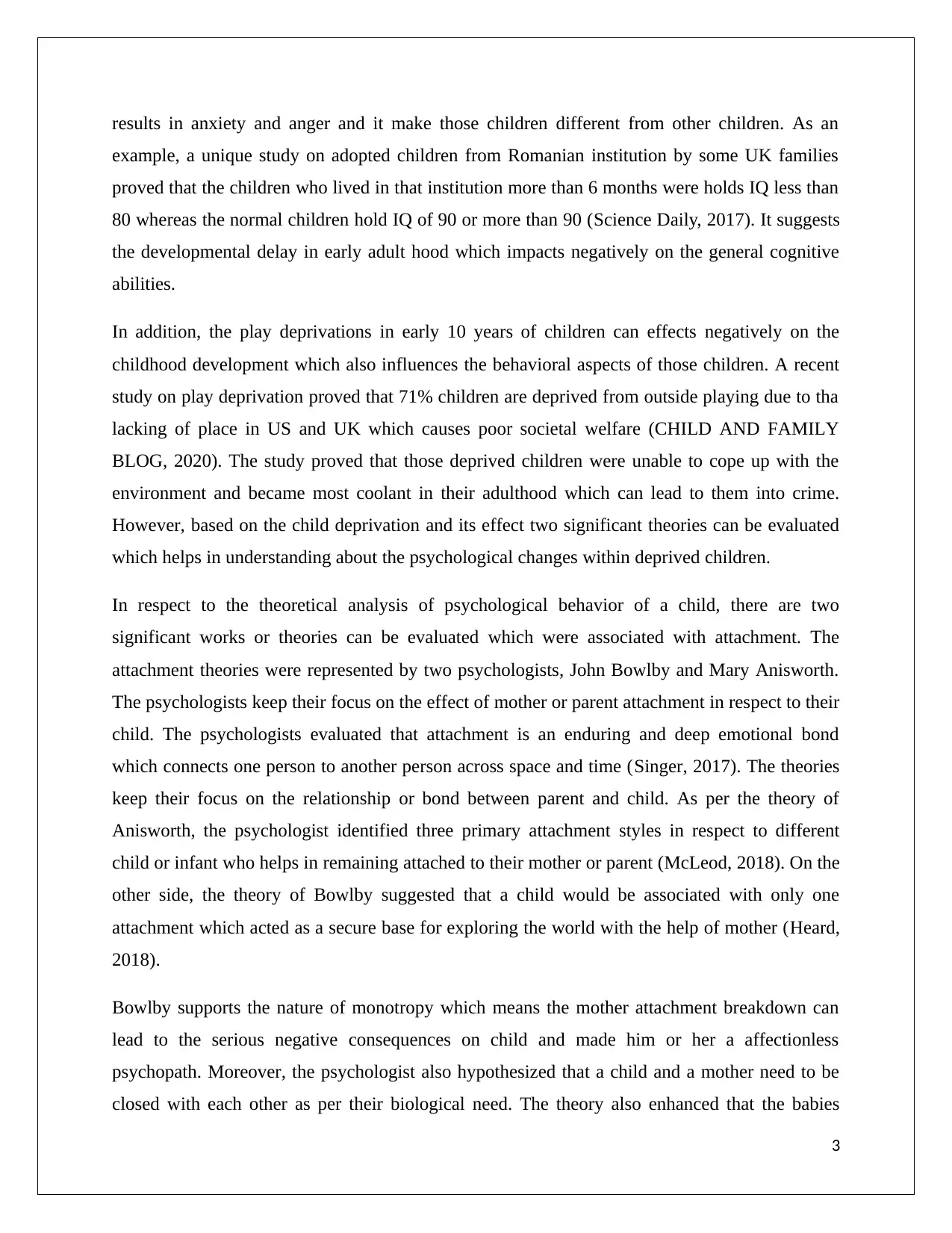
results in anxiety and anger and it make those children different from other children. As an
example, a unique study on adopted children from Romanian institution by some UK families
proved that the children who lived in that institution more than 6 months were holds IQ less than
80 whereas the normal children hold IQ of 90 or more than 90 (Science Daily, 2017). It suggests
the developmental delay in early adult hood which impacts negatively on the general cognitive
abilities.
In addition, the play deprivations in early 10 years of children can effects negatively on the
childhood development which also influences the behavioral aspects of those children. A recent
study on play deprivation proved that 71% children are deprived from outside playing due to tha
lacking of place in US and UK which causes poor societal welfare (CHILD AND FAMILY
BLOG, 2020). The study proved that those deprived children were unable to cope up with the
environment and became most coolant in their adulthood which can lead to them into crime.
However, based on the child deprivation and its effect two significant theories can be evaluated
which helps in understanding about the psychological changes within deprived children.
In respect to the theoretical analysis of psychological behavior of a child, there are two
significant works or theories can be evaluated which were associated with attachment. The
attachment theories were represented by two psychologists, John Bowlby and Mary Anisworth.
The psychologists keep their focus on the effect of mother or parent attachment in respect to their
child. The psychologists evaluated that attachment is an enduring and deep emotional bond
which connects one person to another person across space and time (Singer, 2017). The theories
keep their focus on the relationship or bond between parent and child. As per the theory of
Anisworth, the psychologist identified three primary attachment styles in respect to different
child or infant who helps in remaining attached to their mother or parent (McLeod, 2018). On the
other side, the theory of Bowlby suggested that a child would be associated with only one
attachment which acted as a secure base for exploring the world with the help of mother (Heard,
2018).
Bowlby supports the nature of monotropy which means the mother attachment breakdown can
lead to the serious negative consequences on child and made him or her a affectionless
psychopath. Moreover, the psychologist also hypothesized that a child and a mother need to be
closed with each other as per their biological need. The theory also enhanced that the babies
3
example, a unique study on adopted children from Romanian institution by some UK families
proved that the children who lived in that institution more than 6 months were holds IQ less than
80 whereas the normal children hold IQ of 90 or more than 90 (Science Daily, 2017). It suggests
the developmental delay in early adult hood which impacts negatively on the general cognitive
abilities.
In addition, the play deprivations in early 10 years of children can effects negatively on the
childhood development which also influences the behavioral aspects of those children. A recent
study on play deprivation proved that 71% children are deprived from outside playing due to tha
lacking of place in US and UK which causes poor societal welfare (CHILD AND FAMILY
BLOG, 2020). The study proved that those deprived children were unable to cope up with the
environment and became most coolant in their adulthood which can lead to them into crime.
However, based on the child deprivation and its effect two significant theories can be evaluated
which helps in understanding about the psychological changes within deprived children.
In respect to the theoretical analysis of psychological behavior of a child, there are two
significant works or theories can be evaluated which were associated with attachment. The
attachment theories were represented by two psychologists, John Bowlby and Mary Anisworth.
The psychologists keep their focus on the effect of mother or parent attachment in respect to their
child. The psychologists evaluated that attachment is an enduring and deep emotional bond
which connects one person to another person across space and time (Singer, 2017). The theories
keep their focus on the relationship or bond between parent and child. As per the theory of
Anisworth, the psychologist identified three primary attachment styles in respect to different
child or infant who helps in remaining attached to their mother or parent (McLeod, 2018). On the
other side, the theory of Bowlby suggested that a child would be associated with only one
attachment which acted as a secure base for exploring the world with the help of mother (Heard,
2018).
Bowlby supports the nature of monotropy which means the mother attachment breakdown can
lead to the serious negative consequences on child and made him or her a affectionless
psychopath. Moreover, the psychologist also hypothesized that a child and a mother need to be
closed with each other as per their biological need. The theory also enhanced that the babies
3
⊘ This is a preview!⊘
Do you want full access?
Subscribe today to unlock all pages.

Trusted by 1+ million students worldwide
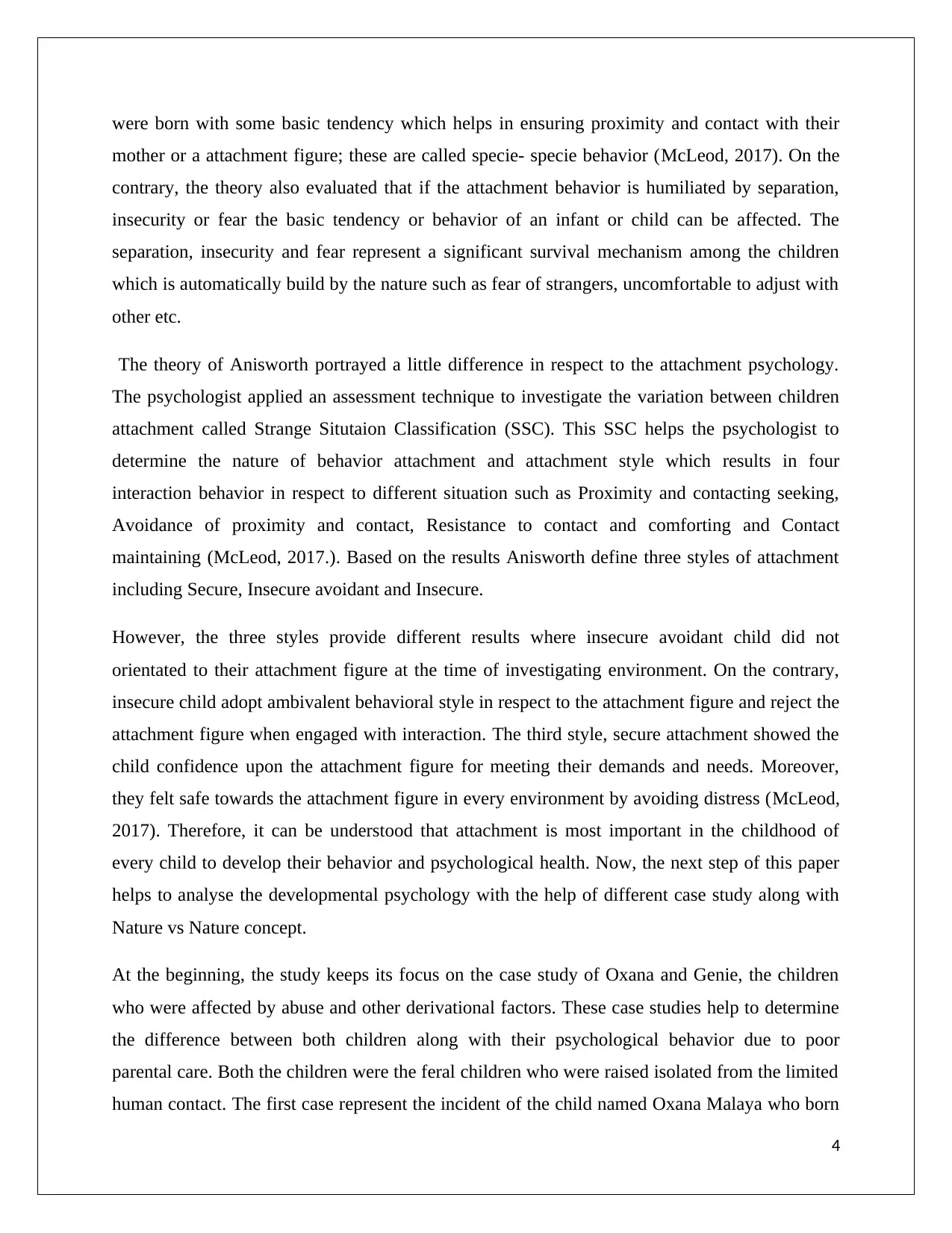
were born with some basic tendency which helps in ensuring proximity and contact with their
mother or a attachment figure; these are called specie- specie behavior (McLeod, 2017). On the
contrary, the theory also evaluated that if the attachment behavior is humiliated by separation,
insecurity or fear the basic tendency or behavior of an infant or child can be affected. The
separation, insecurity and fear represent a significant survival mechanism among the children
which is automatically build by the nature such as fear of strangers, uncomfortable to adjust with
other etc.
The theory of Anisworth portrayed a little difference in respect to the attachment psychology.
The psychologist applied an assessment technique to investigate the variation between children
attachment called Strange Situtaion Classification (SSC). This SSC helps the psychologist to
determine the nature of behavior attachment and attachment style which results in four
interaction behavior in respect to different situation such as Proximity and contacting seeking,
Avoidance of proximity and contact, Resistance to contact and comforting and Contact
maintaining (McLeod, 2017.). Based on the results Anisworth define three styles of attachment
including Secure, Insecure avoidant and Insecure.
However, the three styles provide different results where insecure avoidant child did not
orientated to their attachment figure at the time of investigating environment. On the contrary,
insecure child adopt ambivalent behavioral style in respect to the attachment figure and reject the
attachment figure when engaged with interaction. The third style, secure attachment showed the
child confidence upon the attachment figure for meeting their demands and needs. Moreover,
they felt safe towards the attachment figure in every environment by avoiding distress (McLeod,
2017). Therefore, it can be understood that attachment is most important in the childhood of
every child to develop their behavior and psychological health. Now, the next step of this paper
helps to analyse the developmental psychology with the help of different case study along with
Nature vs Nature concept.
At the beginning, the study keeps its focus on the case study of Oxana and Genie, the children
who were affected by abuse and other derivational factors. These case studies help to determine
the difference between both children along with their psychological behavior due to poor
parental care. Both the children were the feral children who were raised isolated from the limited
human contact. The first case represent the incident of the child named Oxana Malaya who born
4
mother or a attachment figure; these are called specie- specie behavior (McLeod, 2017). On the
contrary, the theory also evaluated that if the attachment behavior is humiliated by separation,
insecurity or fear the basic tendency or behavior of an infant or child can be affected. The
separation, insecurity and fear represent a significant survival mechanism among the children
which is automatically build by the nature such as fear of strangers, uncomfortable to adjust with
other etc.
The theory of Anisworth portrayed a little difference in respect to the attachment psychology.
The psychologist applied an assessment technique to investigate the variation between children
attachment called Strange Situtaion Classification (SSC). This SSC helps the psychologist to
determine the nature of behavior attachment and attachment style which results in four
interaction behavior in respect to different situation such as Proximity and contacting seeking,
Avoidance of proximity and contact, Resistance to contact and comforting and Contact
maintaining (McLeod, 2017.). Based on the results Anisworth define three styles of attachment
including Secure, Insecure avoidant and Insecure.
However, the three styles provide different results where insecure avoidant child did not
orientated to their attachment figure at the time of investigating environment. On the contrary,
insecure child adopt ambivalent behavioral style in respect to the attachment figure and reject the
attachment figure when engaged with interaction. The third style, secure attachment showed the
child confidence upon the attachment figure for meeting their demands and needs. Moreover,
they felt safe towards the attachment figure in every environment by avoiding distress (McLeod,
2017). Therefore, it can be understood that attachment is most important in the childhood of
every child to develop their behavior and psychological health. Now, the next step of this paper
helps to analyse the developmental psychology with the help of different case study along with
Nature vs Nature concept.
At the beginning, the study keeps its focus on the case study of Oxana and Genie, the children
who were affected by abuse and other derivational factors. These case studies help to determine
the difference between both children along with their psychological behavior due to poor
parental care. Both the children were the feral children who were raised isolated from the limited
human contact. The first case represent the incident of the child named Oxana Malaya who born
4
Paraphrase This Document
Need a fresh take? Get an instant paraphrase of this document with our AI Paraphraser
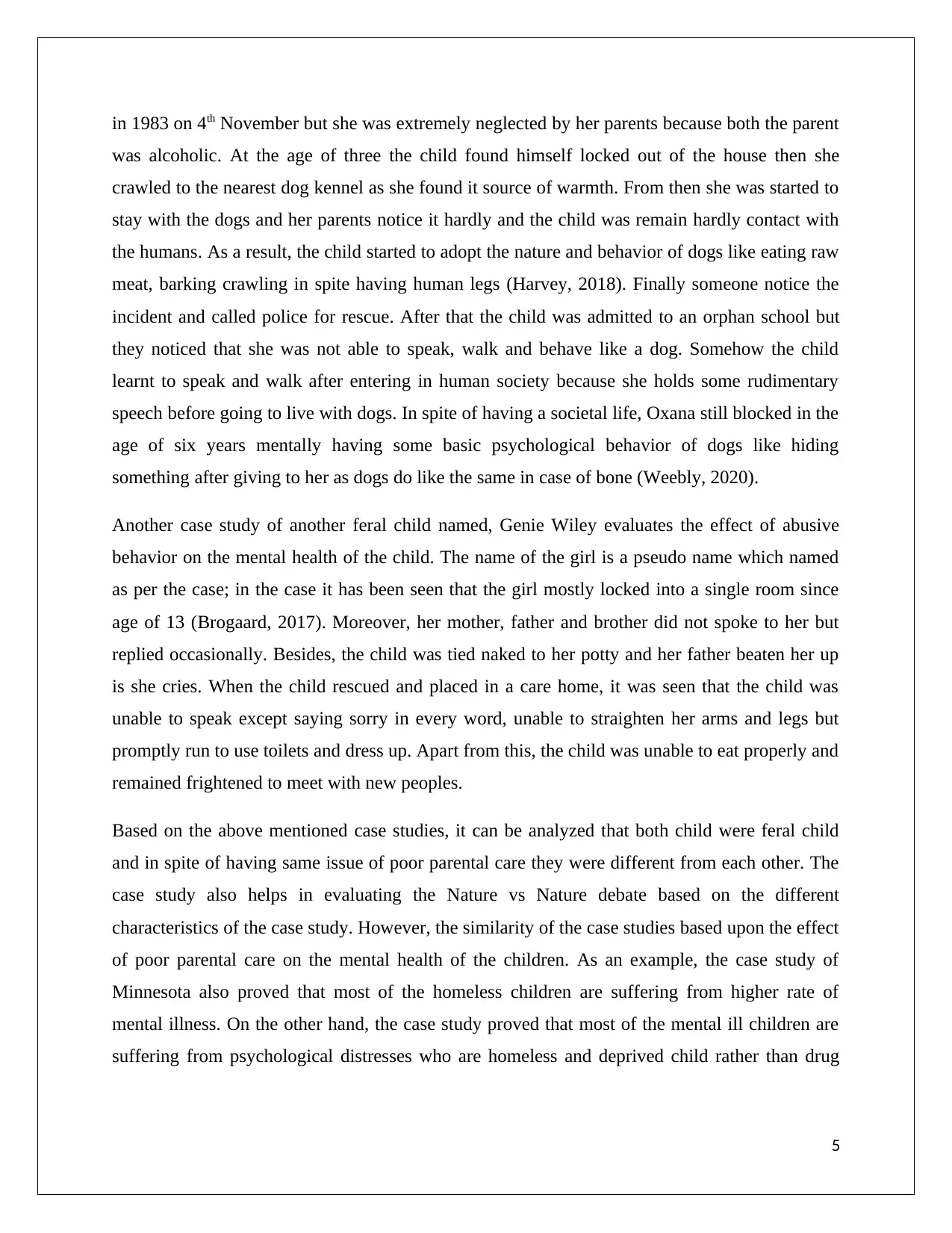
in 1983 on 4th November but she was extremely neglected by her parents because both the parent
was alcoholic. At the age of three the child found himself locked out of the house then she
crawled to the nearest dog kennel as she found it source of warmth. From then she was started to
stay with the dogs and her parents notice it hardly and the child was remain hardly contact with
the humans. As a result, the child started to adopt the nature and behavior of dogs like eating raw
meat, barking crawling in spite having human legs (Harvey, 2018). Finally someone notice the
incident and called police for rescue. After that the child was admitted to an orphan school but
they noticed that she was not able to speak, walk and behave like a dog. Somehow the child
learnt to speak and walk after entering in human society because she holds some rudimentary
speech before going to live with dogs. In spite of having a societal life, Oxana still blocked in the
age of six years mentally having some basic psychological behavior of dogs like hiding
something after giving to her as dogs do like the same in case of bone (Weebly, 2020).
Another case study of another feral child named, Genie Wiley evaluates the effect of abusive
behavior on the mental health of the child. The name of the girl is a pseudo name which named
as per the case; in the case it has been seen that the girl mostly locked into a single room since
age of 13 (Brogaard, 2017). Moreover, her mother, father and brother did not spoke to her but
replied occasionally. Besides, the child was tied naked to her potty and her father beaten her up
is she cries. When the child rescued and placed in a care home, it was seen that the child was
unable to speak except saying sorry in every word, unable to straighten her arms and legs but
promptly run to use toilets and dress up. Apart from this, the child was unable to eat properly and
remained frightened to meet with new peoples.
Based on the above mentioned case studies, it can be analyzed that both child were feral child
and in spite of having same issue of poor parental care they were different from each other. The
case study also helps in evaluating the Nature vs Nature debate based on the different
characteristics of the case study. However, the similarity of the case studies based upon the effect
of poor parental care on the mental health of the children. As an example, the case study of
Minnesota also proved that most of the homeless children are suffering from higher rate of
mental illness. On the other hand, the case study proved that most of the mental ill children are
suffering from psychological distresses who are homeless and deprived child rather than drug
5
was alcoholic. At the age of three the child found himself locked out of the house then she
crawled to the nearest dog kennel as she found it source of warmth. From then she was started to
stay with the dogs and her parents notice it hardly and the child was remain hardly contact with
the humans. As a result, the child started to adopt the nature and behavior of dogs like eating raw
meat, barking crawling in spite having human legs (Harvey, 2018). Finally someone notice the
incident and called police for rescue. After that the child was admitted to an orphan school but
they noticed that she was not able to speak, walk and behave like a dog. Somehow the child
learnt to speak and walk after entering in human society because she holds some rudimentary
speech before going to live with dogs. In spite of having a societal life, Oxana still blocked in the
age of six years mentally having some basic psychological behavior of dogs like hiding
something after giving to her as dogs do like the same in case of bone (Weebly, 2020).
Another case study of another feral child named, Genie Wiley evaluates the effect of abusive
behavior on the mental health of the child. The name of the girl is a pseudo name which named
as per the case; in the case it has been seen that the girl mostly locked into a single room since
age of 13 (Brogaard, 2017). Moreover, her mother, father and brother did not spoke to her but
replied occasionally. Besides, the child was tied naked to her potty and her father beaten her up
is she cries. When the child rescued and placed in a care home, it was seen that the child was
unable to speak except saying sorry in every word, unable to straighten her arms and legs but
promptly run to use toilets and dress up. Apart from this, the child was unable to eat properly and
remained frightened to meet with new peoples.
Based on the above mentioned case studies, it can be analyzed that both child were feral child
and in spite of having same issue of poor parental care they were different from each other. The
case study also helps in evaluating the Nature vs Nature debate based on the different
characteristics of the case study. However, the similarity of the case studies based upon the effect
of poor parental care on the mental health of the children. As an example, the case study of
Minnesota also proved that most of the homeless children are suffering from higher rate of
mental illness. On the other hand, the case study proved that most of the mental ill children are
suffering from psychological distresses who are homeless and deprived child rather than drug
5
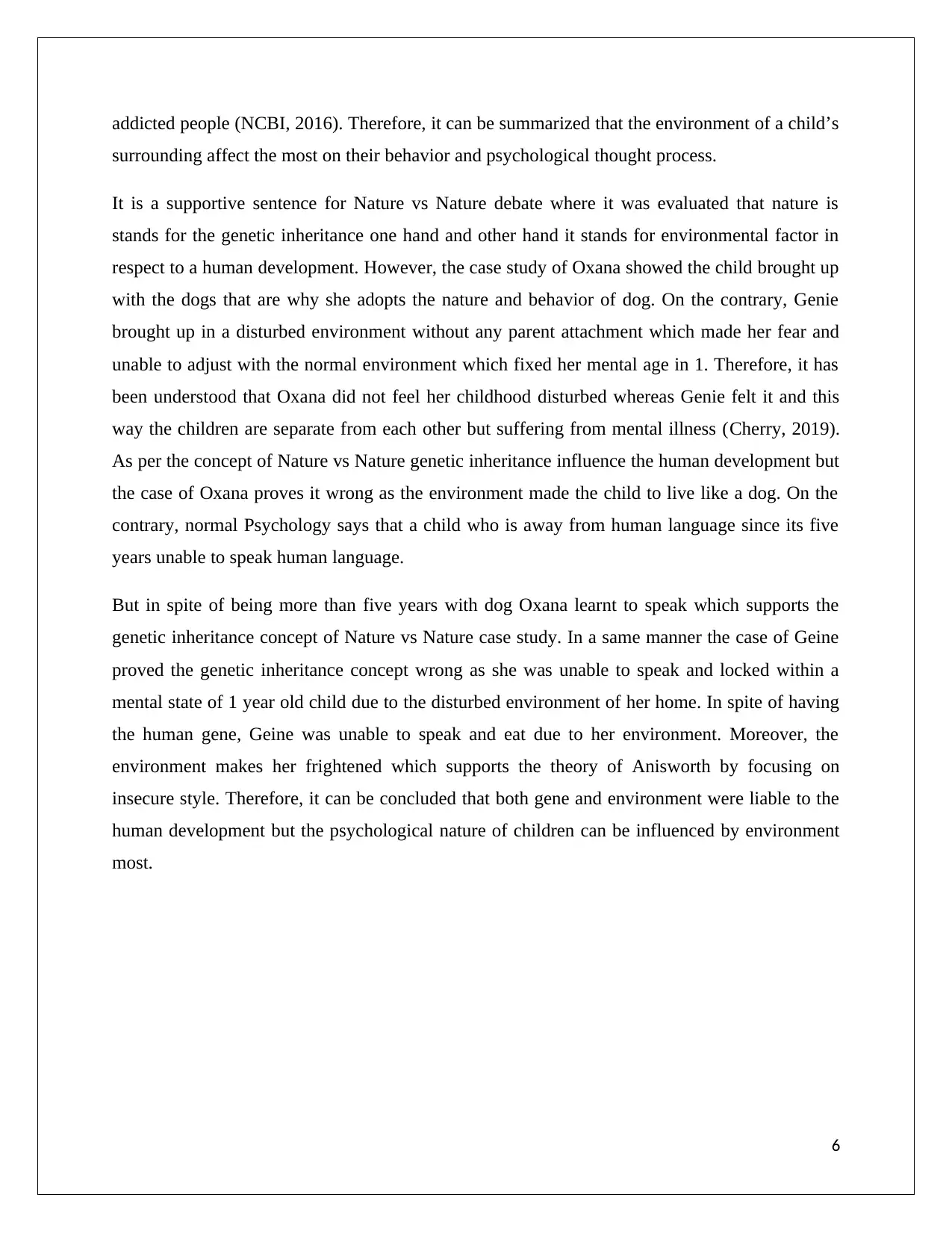
addicted people (NCBI, 2016). Therefore, it can be summarized that the environment of a child’s
surrounding affect the most on their behavior and psychological thought process.
It is a supportive sentence for Nature vs Nature debate where it was evaluated that nature is
stands for the genetic inheritance one hand and other hand it stands for environmental factor in
respect to a human development. However, the case study of Oxana showed the child brought up
with the dogs that are why she adopts the nature and behavior of dog. On the contrary, Genie
brought up in a disturbed environment without any parent attachment which made her fear and
unable to adjust with the normal environment which fixed her mental age in 1. Therefore, it has
been understood that Oxana did not feel her childhood disturbed whereas Genie felt it and this
way the children are separate from each other but suffering from mental illness (Cherry, 2019).
As per the concept of Nature vs Nature genetic inheritance influence the human development but
the case of Oxana proves it wrong as the environment made the child to live like a dog. On the
contrary, normal Psychology says that a child who is away from human language since its five
years unable to speak human language.
But in spite of being more than five years with dog Oxana learnt to speak which supports the
genetic inheritance concept of Nature vs Nature case study. In a same manner the case of Geine
proved the genetic inheritance concept wrong as she was unable to speak and locked within a
mental state of 1 year old child due to the disturbed environment of her home. In spite of having
the human gene, Geine was unable to speak and eat due to her environment. Moreover, the
environment makes her frightened which supports the theory of Anisworth by focusing on
insecure style. Therefore, it can be concluded that both gene and environment were liable to the
human development but the psychological nature of children can be influenced by environment
most.
6
surrounding affect the most on their behavior and psychological thought process.
It is a supportive sentence for Nature vs Nature debate where it was evaluated that nature is
stands for the genetic inheritance one hand and other hand it stands for environmental factor in
respect to a human development. However, the case study of Oxana showed the child brought up
with the dogs that are why she adopts the nature and behavior of dog. On the contrary, Genie
brought up in a disturbed environment without any parent attachment which made her fear and
unable to adjust with the normal environment which fixed her mental age in 1. Therefore, it has
been understood that Oxana did not feel her childhood disturbed whereas Genie felt it and this
way the children are separate from each other but suffering from mental illness (Cherry, 2019).
As per the concept of Nature vs Nature genetic inheritance influence the human development but
the case of Oxana proves it wrong as the environment made the child to live like a dog. On the
contrary, normal Psychology says that a child who is away from human language since its five
years unable to speak human language.
But in spite of being more than five years with dog Oxana learnt to speak which supports the
genetic inheritance concept of Nature vs Nature case study. In a same manner the case of Geine
proved the genetic inheritance concept wrong as she was unable to speak and locked within a
mental state of 1 year old child due to the disturbed environment of her home. In spite of having
the human gene, Geine was unable to speak and eat due to her environment. Moreover, the
environment makes her frightened which supports the theory of Anisworth by focusing on
insecure style. Therefore, it can be concluded that both gene and environment were liable to the
human development but the psychological nature of children can be influenced by environment
most.
6
⊘ This is a preview!⊘
Do you want full access?
Subscribe today to unlock all pages.

Trusted by 1+ million students worldwide
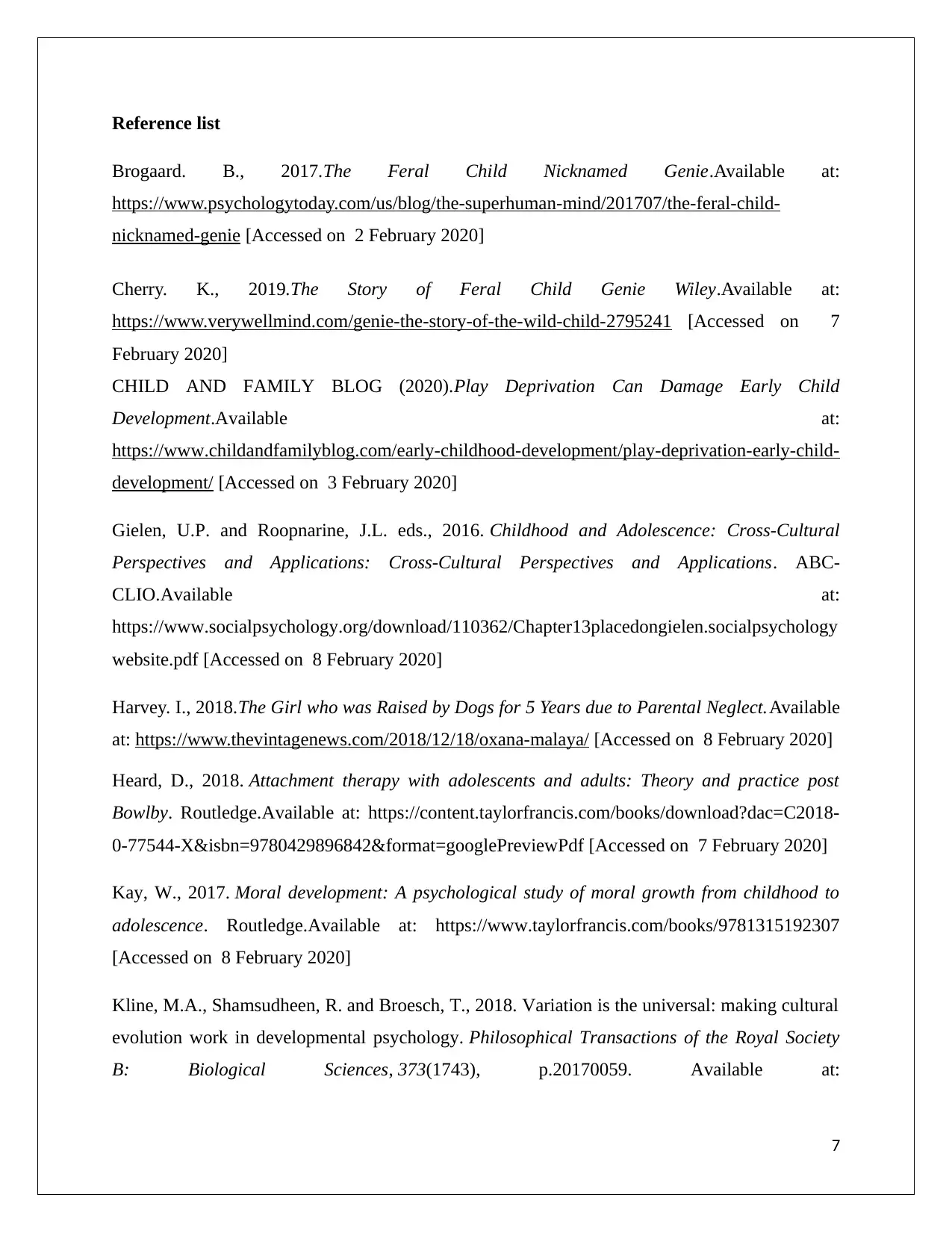
Reference list
Brogaard. B., 2017.The Feral Child Nicknamed Genie.Available at:
https://www.psychologytoday.com/us/blog/the-superhuman-mind/201707/the-feral-child-
nicknamed-genie [Accessed on 2 February 2020]
Cherry. K., 2019.The Story of Feral Child Genie Wiley.Available at:
https://www.verywellmind.com/genie-the-story-of-the-wild-child-2795241 [Accessed on 7
February 2020]
CHILD AND FAMILY BLOG (2020).Play Deprivation Can Damage Early Child
Development.Available at:
https://www.childandfamilyblog.com/early-childhood-development/play-deprivation-early-child-
development/ [Accessed on 3 February 2020]
Gielen, U.P. and Roopnarine, J.L. eds., 2016. Childhood and Adolescence: Cross-Cultural
Perspectives and Applications: Cross-Cultural Perspectives and Applications. ABC-
CLIO.Available at:
https://www.socialpsychology.org/download/110362/Chapter13placedongielen.socialpsychology
website.pdf [Accessed on 8 February 2020]
Harvey. I., 2018.The Girl who was Raised by Dogs for 5 Years due to Parental Neglect.Available
at: https://www.thevintagenews.com/2018/12/18/oxana-malaya/ [Accessed on 8 February 2020]
Heard, D., 2018. Attachment therapy with adolescents and adults: Theory and practice post
Bowlby. Routledge.Available at: https://content.taylorfrancis.com/books/download?dac=C2018-
0-77544-X&isbn=9780429896842&format=googlePreviewPdf [Accessed on 7 February 2020]
Kay, W., 2017. Moral development: A psychological study of moral growth from childhood to
adolescence. Routledge.Available at: https://www.taylorfrancis.com/books/9781315192307
[Accessed on 8 February 2020]
Kline, M.A., Shamsudheen, R. and Broesch, T., 2018. Variation is the universal: making cultural
evolution work in developmental psychology. Philosophical Transactions of the Royal Society
B: Biological Sciences, 373(1743), p.20170059. Available at:
7
Brogaard. B., 2017.The Feral Child Nicknamed Genie.Available at:
https://www.psychologytoday.com/us/blog/the-superhuman-mind/201707/the-feral-child-
nicknamed-genie [Accessed on 2 February 2020]
Cherry. K., 2019.The Story of Feral Child Genie Wiley.Available at:
https://www.verywellmind.com/genie-the-story-of-the-wild-child-2795241 [Accessed on 7
February 2020]
CHILD AND FAMILY BLOG (2020).Play Deprivation Can Damage Early Child
Development.Available at:
https://www.childandfamilyblog.com/early-childhood-development/play-deprivation-early-child-
development/ [Accessed on 3 February 2020]
Gielen, U.P. and Roopnarine, J.L. eds., 2016. Childhood and Adolescence: Cross-Cultural
Perspectives and Applications: Cross-Cultural Perspectives and Applications. ABC-
CLIO.Available at:
https://www.socialpsychology.org/download/110362/Chapter13placedongielen.socialpsychology
website.pdf [Accessed on 8 February 2020]
Harvey. I., 2018.The Girl who was Raised by Dogs for 5 Years due to Parental Neglect.Available
at: https://www.thevintagenews.com/2018/12/18/oxana-malaya/ [Accessed on 8 February 2020]
Heard, D., 2018. Attachment therapy with adolescents and adults: Theory and practice post
Bowlby. Routledge.Available at: https://content.taylorfrancis.com/books/download?dac=C2018-
0-77544-X&isbn=9780429896842&format=googlePreviewPdf [Accessed on 7 February 2020]
Kay, W., 2017. Moral development: A psychological study of moral growth from childhood to
adolescence. Routledge.Available at: https://www.taylorfrancis.com/books/9781315192307
[Accessed on 8 February 2020]
Kline, M.A., Shamsudheen, R. and Broesch, T., 2018. Variation is the universal: making cultural
evolution work in developmental psychology. Philosophical Transactions of the Royal Society
B: Biological Sciences, 373(1743), p.20170059. Available at:
7
Paraphrase This Document
Need a fresh take? Get an instant paraphrase of this document with our AI Paraphraser
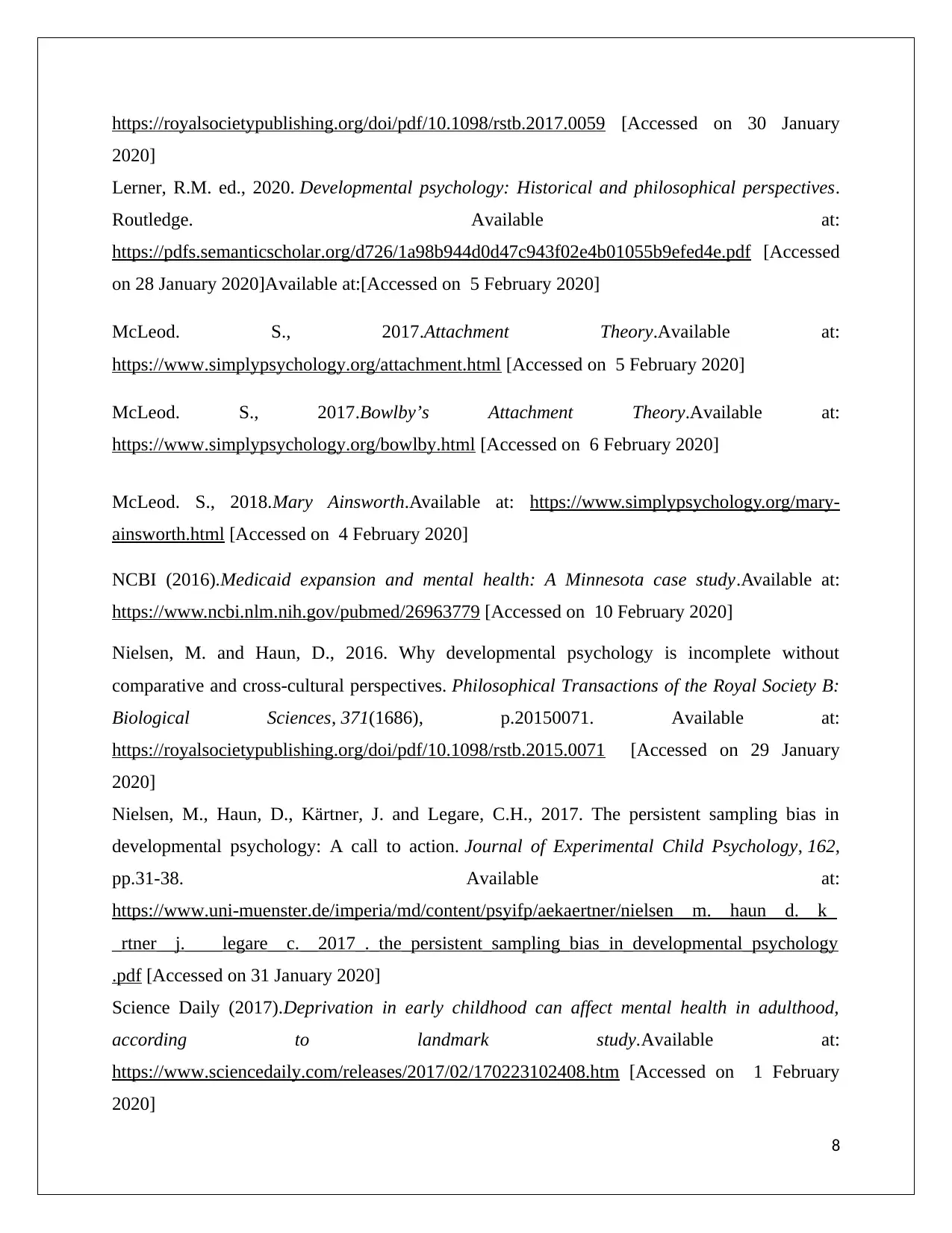
https://royalsocietypublishing.org/doi/pdf/10.1098/rstb.2017.0059 [Accessed on 30 January
2020]
Lerner, R.M. ed., 2020. Developmental psychology: Historical and philosophical perspectives.
Routledge. Available at:
https://pdfs.semanticscholar.org/d726/1a98b944d0d47c943f02e4b01055b9efed4e.pdf [Accessed
on 28 January 2020]Available at:[Accessed on 5 February 2020]
McLeod. S., 2017.Attachment Theory.Available at:
https://www.simplypsychology.org/attachment.html [Accessed on 5 February 2020]
McLeod. S., 2017.Bowlby’s Attachment Theory.Available at:
https://www.simplypsychology.org/bowlby.html [Accessed on 6 February 2020]
McLeod. S., 2018.Mary Ainsworth.Available at: https://www.simplypsychology.org/mary-
ainsworth.html [Accessed on 4 February 2020]
NCBI (2016).Medicaid expansion and mental health: A Minnesota case study.Available at:
https://www.ncbi.nlm.nih.gov/pubmed/26963779 [Accessed on 10 February 2020]
Nielsen, M. and Haun, D., 2016. Why developmental psychology is incomplete without
comparative and cross-cultural perspectives. Philosophical Transactions of the Royal Society B:
Biological Sciences, 371(1686), p.20150071. Available at:
https://royalsocietypublishing.org/doi/pdf/10.1098/rstb.2015.0071 [Accessed on 29 January
2020]
Nielsen, M., Haun, D., Kärtner, J. and Legare, C.H., 2017. The persistent sampling bias in
developmental psychology: A call to action. Journal of Experimental Child Psychology, 162,
pp.31-38. Available at:
https://www.uni-muenster.de/imperia/md/content/psyifp/aekaertner/nielsen__m.__haun__d.__k_
_rtner__j.____legare__c.__2017_._the_persistent_sampling_bias_in_developmental_psychology
.pdf [Accessed on 31 January 2020]
Science Daily (2017).Deprivation in early childhood can affect mental health in adulthood,
according to landmark study.Available at:
https://www.sciencedaily.com/releases/2017/02/170223102408.htm [Accessed on 1 February
2020]
8
2020]
Lerner, R.M. ed., 2020. Developmental psychology: Historical and philosophical perspectives.
Routledge. Available at:
https://pdfs.semanticscholar.org/d726/1a98b944d0d47c943f02e4b01055b9efed4e.pdf [Accessed
on 28 January 2020]Available at:[Accessed on 5 February 2020]
McLeod. S., 2017.Attachment Theory.Available at:
https://www.simplypsychology.org/attachment.html [Accessed on 5 February 2020]
McLeod. S., 2017.Bowlby’s Attachment Theory.Available at:
https://www.simplypsychology.org/bowlby.html [Accessed on 6 February 2020]
McLeod. S., 2018.Mary Ainsworth.Available at: https://www.simplypsychology.org/mary-
ainsworth.html [Accessed on 4 February 2020]
NCBI (2016).Medicaid expansion and mental health: A Minnesota case study.Available at:
https://www.ncbi.nlm.nih.gov/pubmed/26963779 [Accessed on 10 February 2020]
Nielsen, M. and Haun, D., 2016. Why developmental psychology is incomplete without
comparative and cross-cultural perspectives. Philosophical Transactions of the Royal Society B:
Biological Sciences, 371(1686), p.20150071. Available at:
https://royalsocietypublishing.org/doi/pdf/10.1098/rstb.2015.0071 [Accessed on 29 January
2020]
Nielsen, M., Haun, D., Kärtner, J. and Legare, C.H., 2017. The persistent sampling bias in
developmental psychology: A call to action. Journal of Experimental Child Psychology, 162,
pp.31-38. Available at:
https://www.uni-muenster.de/imperia/md/content/psyifp/aekaertner/nielsen__m.__haun__d.__k_
_rtner__j.____legare__c.__2017_._the_persistent_sampling_bias_in_developmental_psychology
.pdf [Accessed on 31 January 2020]
Science Daily (2017).Deprivation in early childhood can affect mental health in adulthood,
according to landmark study.Available at:
https://www.sciencedaily.com/releases/2017/02/170223102408.htm [Accessed on 1 February
2020]
8
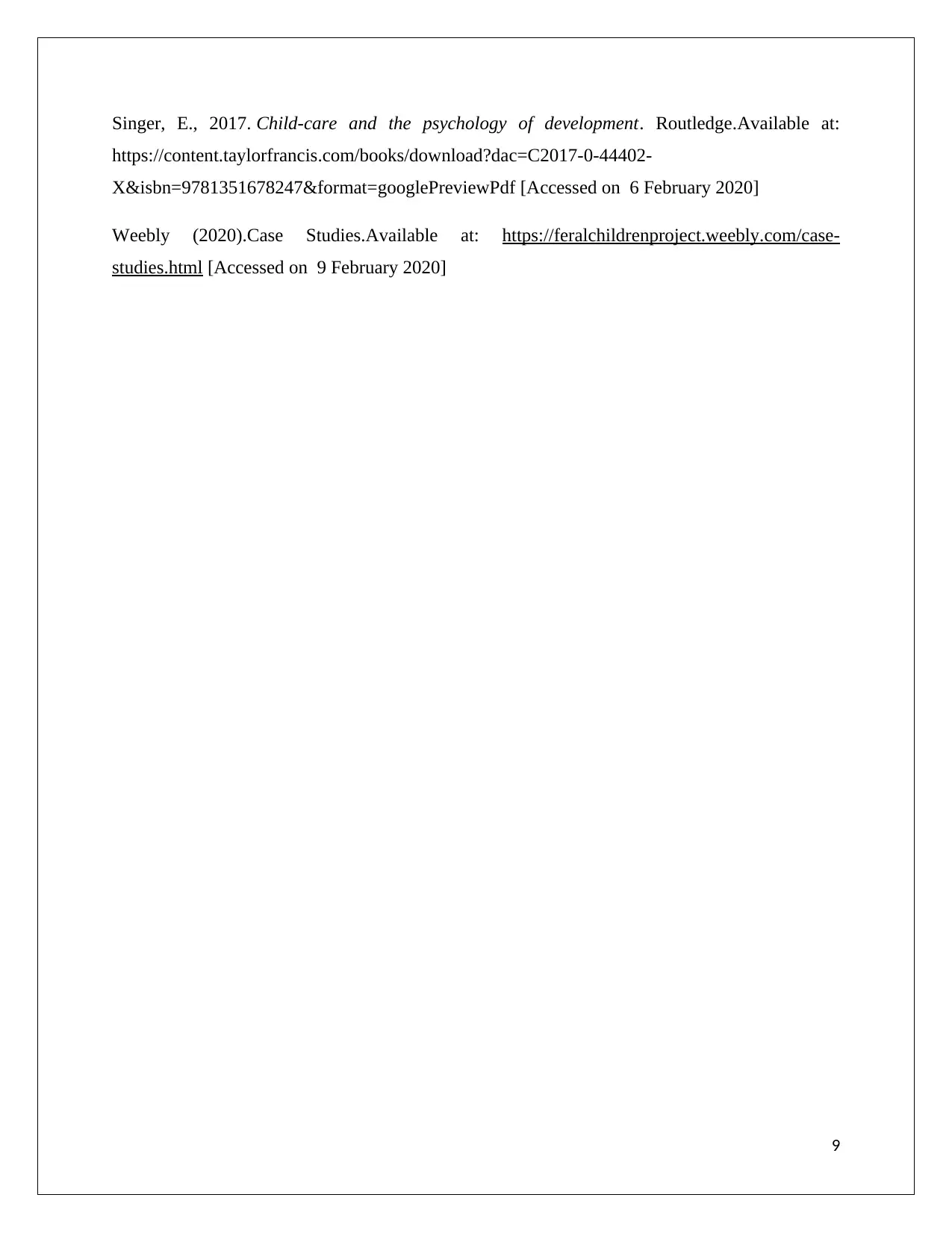
Singer, E., 2017. Child-care and the psychology of development. Routledge.Available at:
https://content.taylorfrancis.com/books/download?dac=C2017-0-44402-
X&isbn=9781351678247&format=googlePreviewPdf [Accessed on 6 February 2020]
Weebly (2020).Case Studies.Available at: https://feralchildrenproject.weebly.com/case-
studies.html [Accessed on 9 February 2020]
9
https://content.taylorfrancis.com/books/download?dac=C2017-0-44402-
X&isbn=9781351678247&format=googlePreviewPdf [Accessed on 6 February 2020]
Weebly (2020).Case Studies.Available at: https://feralchildrenproject.weebly.com/case-
studies.html [Accessed on 9 February 2020]
9
⊘ This is a preview!⊘
Do you want full access?
Subscribe today to unlock all pages.

Trusted by 1+ million students worldwide
1 out of 9
Related Documents
Your All-in-One AI-Powered Toolkit for Academic Success.
+13062052269
info@desklib.com
Available 24*7 on WhatsApp / Email
![[object Object]](/_next/static/media/star-bottom.7253800d.svg)
Unlock your academic potential
Copyright © 2020–2025 A2Z Services. All Rights Reserved. Developed and managed by ZUCOL.




